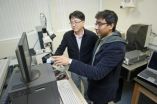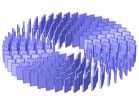(Press-News.org) Every second, your computer must process billions of computational steps to produce even the simplest outputs. Imagine if every one of those steps could be made just a tiny bit more efficient. "It would save precious nanoseconds," explained Northeastern University assistant professor of physics Swastik Kar.
Kar and his colleague Yung Joon Jung, an associate professor in the Department of Mechanical and Industrial Engineering, have developed a series of novel devices that do just that. Their work was published recently in the journal Nature Photonics.
Last year, the interdisciplinary duo combined their expertise—Kar's in graphene, a carbon-based material known for its strength and conductivity, and Jung's in the mechanics of carbon nanotubes, which are nanometer-sized rolled up sheets of graphene—to unearth a physical phenomenon that could usher in a new wave of highly efficient electronics.
They discovered that light-induced electrical currents rise much more sharply at the intersection of carbon nanotubes and silicon, compared to the intersection of silicon and a metal, as in traditional photodiode devices. "That sharp rise helps us design devices that can be turned on and off using light," Kar said.
This finding has major implications for performing computations, which, in simple terms, also rely on a series of on-off switches. But in order to access the valuable information that can be stored on these switches, it must also be transferred to and processed by other switches. "People believe that the best computer would be one in which the processing is done using electrical signals and the signal transfer is done by optics," Kar said.
This isn't too surprising since light is extremely fast. Kar and Jung's devices—which are the first to integrate electronic and optical properties on a single electronic chip—represent a critical breakthrough in making this dream computer a reality.
The computational modeling of these junctions were performed in close collaboration with the group of Young-Kyun Kwon, a professor at Kyung Hee University, in Seoul, Korea.
In the new paper, the team presents three such new devices. The first is a so-called AND-gate, which requires both an electronic and an optical input to generate an output. This switch only triggers if both elements are engaged.
The second device, an OR-gate, can generate an output if either of two optical sensors is engaged. This same configuration can also be used to convert digital signals into analog ones, an important capability for actions such as turning the digital content of an MP3 file into actual music.
Finally, Kar and Jung also built a device that works like the front-end of a camera sensor. It consists of 250,000 miniature devices assembled over a centimeter-by-centimeter surface. While this device would require more integration to be fully viable, it allowed the team to test the reproducibility of their assembly process.
"Jung's method is a world-class technique," Kar said. "It has really enabled us to design a lot of devices that are much more scalable."
While computers process billions of computational steps each second, improving their capability of performing those steps, Kar said, begins with the "demonstration of improving just one." Which is exactly what they've done.
INFORMATION: END
New approach to chip design could yield light speed computing
2014-02-25
ELSE PRESS RELEASES FROM THIS DATE:
Geology covers Mars, the Moon, anthropogenic lead poisoning, earthquake hazards, and more
2014-02-25
Boulder, Colo., USA – The Geological Society of America's top journal, Geology, displays its multidisciplinary best in this latest posting. Earth science disciplines covered include geoarchaeology, climatology, invertebrate paleontology, sedimentology, geomorphology, seismology, planetary geology, geochemistry, glaciology, plate tectonics, mineralogy, and environmental and medical geology. Locations include Mars; Earth's moon; India; the Tibetan Plateau; the Saskatchewan River; L'Aquila, Italy; the Antarctic; Australia; the Andes; the San Andreas fault system; and Kume ...
Scientists twist sound with metamaterials
2014-02-25
WASHINGTON D.C. Feb. 25, 2014 -- A Chinese-U.S. research team is exploring the use of metamaterials -- artificial materials engineered to have exotic properties not found in nature -- to create devices that manipulate sound in versatile and unprecedented ways.
In the journal Applied Physics Letters, the team reports a simple design for a device, called an acoustic field rotator, which can twist wavefronts inside it so that they appear to be propagating from another direction.
"Numerous research efforts have centered on metamaterial-based devices with fascinating wave-control ...
Improvement in polymers for aviation
2014-02-25
We live surrounded by polymers and today, rather than come up with new polymers, there is a tendency to modify them in order to obtain new applications. Carbon nanotubes have excellent mechanical properties, are very tough, very rigid, and what is more, they conduct electricity. "The problem with them is that they get dispersed, in other words, it's very difficult to get them to blend with polymers," explained Iñaki Eguiazabal, a member of the Polymer Technology Group. That is why it is essential to come up with methods that will enablethe carbon nanotubes to have a ...
'Greener' aerogel technology holds potential for oil and chemical clean-up
2014-02-25
MADISON, Wis. – Cleaning up oil spills and metal contaminates in a low-impact, sustainable and inexpensive manner remains a challenge for companies and governments globally.
But a group of researchers at the University of Wisconsin–Madison is examining alternative materials that can be modified to absorb oil and chemicals without absorbing water. If further developed, the technology may offer a cheaper and "greener" method to absorb oil and heavy metals from water and other surfaces.
Shaoqin "Sarah" Gong, a researcher at the Wisconsin Institute for Discovery (WID) ...
Glycerol phenylbutyrate reduces hepatic encephalopathy events
2014-02-25
Phase 2 trial results published in the March issue of Hepatology, a journal of the American Association for the Study of Liver Diseases, suggests the potential for Glycerol Phenylbutyrate (GPB) to reduce hepatic encephalopathy episodes in patients with cirrhosis, with a safety profile similar to placebo.
Patients with hepatic encephalopathy experience neuropsychiatric symptoms that may range from mild confusion to coma. There is conflicting evidence on the link between elevated blood ammonia and hepatic encephalopathy. Poorly-absorbable disaccharides and antibiotics ...
Sensor-based irrigation systems show potential to increase greenhouse profitability
2014-02-25
COLLEGE PARK, MD--Wireless sensor-based irrigation systems can offer significant benefits to greenhouse operators. Advances in sensor technology and increased understanding of plant physiology have made it possible for greenhouse growers to use water content sensors to accurately determine irrigation timing and application rates in soilless substrates. The wireless sensor systems provide more accurate measurements of substrate moisture than qualitative methods, and can save irrigation water, labor, energy, and fertilizer. The authors of a report published in HortTechnology ...
Technique to create holes in graphene could improve water filters, desalination
2014-02-25
Researchers have devised a way of making tiny holes of controllable size in sheets of graphene, a development that could lead to ultrathin filters for improved desalination or water purification.
The team of researchers at MIT, Oak Ridge National Laboratory, and in Saudi Arabia succeeded in creating subnanoscale pores in a sheet of the one-atom-thick material, which is one of the strongest materials known. Their findings are published in the journal Nano Letters.
The concept of using graphene, perforated by nanoscale pores, as a filter in desalination has been proposed ...
Report details multiple commercial uses of wireless sensor networks
2014-02-25
ATHENS, GA--Managing the quality and quantity of freshwater resources is one of the most serious environmental challenges of the 21st century. Global population growth and increasing urbanization have resulted in increased competition for water resources among domestic, industrial, and agricultural users. Challenged to find ways to manage irrigation needs while recognizing the limitations of freshwater resources, many commercial horticulture operations are showing increased interest in the use of wireless sensor networks (WSN)--technology designed to both monitor and control ...
Analysis: 32 years of US filicide arrests
2014-02-25
PROVIDENCE, R.I. [Brown University] — Instances in which parents kill their children may seem so horrifying and tragic that they defy explanation. Published scientific and medical research, meanwhile, doesn't offer much epidemiological context to help people understand patterns among such heinous crimes. A paper in the March edition of the journal Forensic Science International provides the first comprehensive statistical analysis of filicide in the United States, drawing on 32 years of data on more than 94,000 arrests. The study also explores possible underlying psychiatric ...
CWRU researchers find byproducts of bacteria-causing gum disease incite oral cancer growth
2014-02-25
Researchers from Case Western Reserve University have discovered how byproducts in the form of small fatty acids from two bacteria prevalent in gum disease incite the growth of deadly Kaposi's sarcoma-related (KS) lesions and tumors in the mouth.
The discovery could lead to early saliva testing for the bacteria, which, if found, could be treated and monitored for signs of cancer and before it develops into a malignancy, researchers say.
"These new findings provide one of the first looks at how the periodontal bacteria create a unique microenvironment in the oral cavity ...



